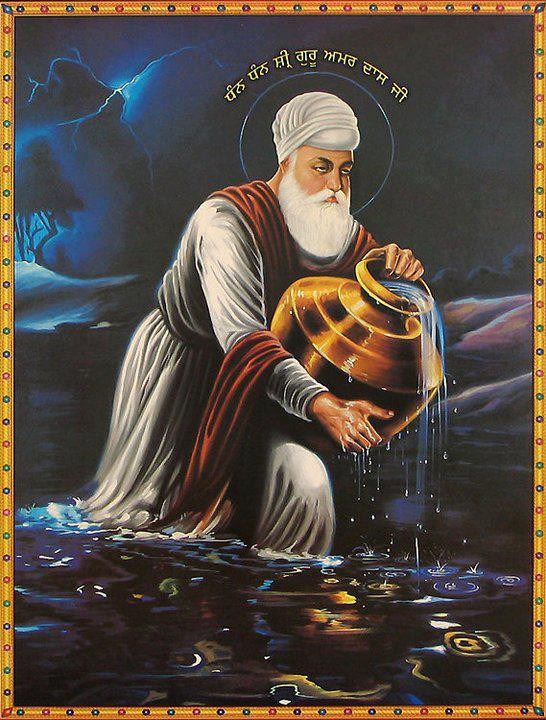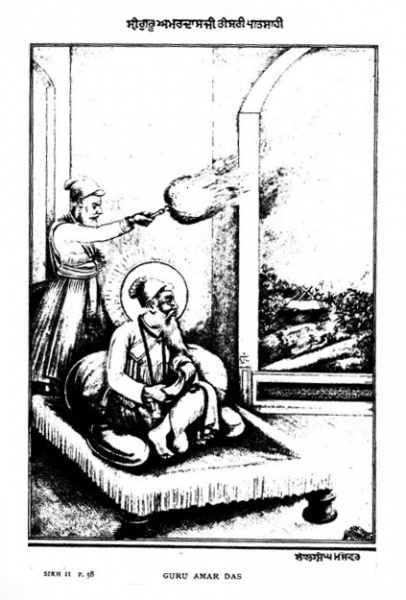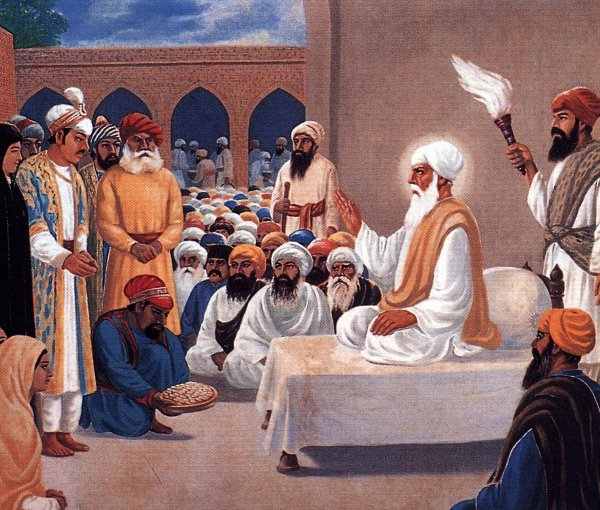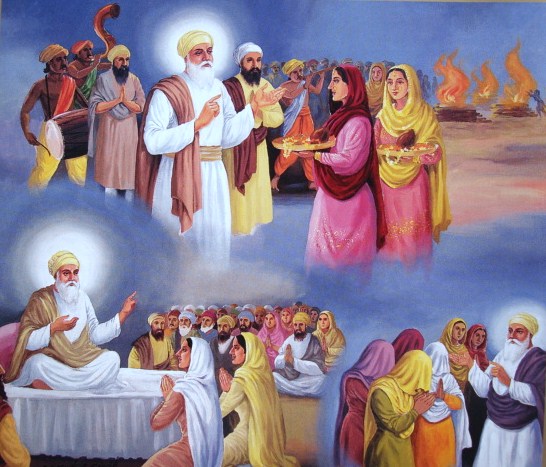Guru Amar Das Ji
 Guru Amar Das Ji
Guru Amar Das Ji
Guru Amar Das Ji, the third of the ten Gurus, was born into a Bhalla Khatri Family on 5 May, 1479, at Basarke, in present-day Amritsar district of Punjab. Guruji was married to Mansa Devi, daughter of Devi Chand, from where he had four children – two sons, Mohri and Mohan, and two daughters, Dani and Bhani. Guru Amar Das Sahib contributed the following to the people of the world:
Guru Amar Das Ji
1. An aggregate of 907 life-changing songs, that are consolidated in the Sri Guru Granth Sahib Ji.
Guru Amar Das Ji
2. Endowment of the petition Anand Sahib Ji, which is one of the Five Banis discussed day by day by faithful Sikhs.
Guru Amar Das Ji
3. All guests (from any position, statement of faith, positioning, societal position) to Gurdwaras were asked to first share in Langar (a free collective feast) before observing the Guru (First Pangat, at that point Sangat). At the point when sovereign Akbar visited the Guru Ji, he too first sat as an ordinary person in the Langar, and after that had a gathering with the Guru.
Guru Amar Das Ji
4. Guru ji lifted the status of ladies and gave them uniformity with men. He entirely restricted practices, for example, Sati (the consuming of the spouse on her significant other’s memorial service fire), Parda (cloak to cover the face), and supported dowager remarriage.
Guru Amar Das Ji
5. Built-up an organizational framework for admit he nitration of the expanding size of the Sikh assemblies, called Manjis.
Guru Amar Das Ji
6. Built-up the city of Goindval on the banks of waterway Beas in 1552 A.D.
Guru Amar Das Ji
Manji System: – At Goindwal, Guru Amar Das Ji spread the Sikh confidence in a legitimate and arranged way. He himself visited and sent Sikh preachers to various parts of India to spread Sikhism. He separated the Sikh Sangat territory into 22 branches considered Manjis and named a nearby sincere Sikh minister at each place. The evangelist sat on a Manji (a bunk) while the assembly all sat around the Manji or bed. Here are the underlying 16 names of the general population he designated to lecture Sikhism. In the region of Majha (Amritsar, Lahore, Sialkot)
1. Manak Chand Jhinwar (Water Carrier) at Variowal in Amritsar.
2. Sada smash, a Blacksmith close Amritsar.
3. Hindal at Jandiala close Amritsar.
4. Gangu Shah broker at Lahore.
5. Mutho-Murari, a committed couple, at Chunian in Lahore Dist.
In Jalandhar Doab
6. Paro Julka at Jalandar.
7. Mahesh Dhir at Sultanpur Lodi.
8. Rang Shah at Moluphota.
In Kangra Hills
Langar Sewadar, Bhai Handal bows to Guru Amar Das
9. Sawan mal, Nephew of Guru Amar Das, at Haripur Guler.
10. Name not given, at Dharamsala.
Kashmir Hills
11. Phirya at Mirpur.
Malwa (Area of Patiala, Ludhiana, Bhatinda)
12. Kheira at Firozpur.
13. Mai Das Bairagi accountable for Ludhiana dist.
14. Mai Bhago at town Wayun, tehsil Kharar, dist. Rupar.
15. Mai Sewan at Village Gardnoh in Patiala District.
16. Sachna Shah accountable for Ambala district.
Guru Amar Das Ji
Visit of Akbar : –

Master Ji reinforced the custom of ‘Master ka Langar’ and made it necessary for the guest to the Guru saying that ‘Pehle Pangat Phir Sangat’ (first visit the Langar at that point go to the Guru). Once the head Akbar came to see Guru Sahib and he needed to eat the coarse rice in the Langar before he could have a meeting with Guru Sahib.
He was excessively awed with this framework that he communicated his craving to concede some regal property for ‘Master ka Langar’, however Guru Sahib declined it with deference. Master Amardas Sahib convinced Akbar to postpone off toll-impose (explorer’s duty) for non-Muslims while crossing Yamuna and Ganga, Akbar did as such. Master Amardas Sahib kept up heartfelt relations with head Akbar.
Preachings : –
Guru Amar Das Ji
Social Changes : –

He lectured against Sati and supported the re-wedding of dowagers. He requested that the ladies dispose of ‘Purdah’ (cover). He presented new birth, marriage and demise functions. Consequently, he raised the status of ladies and secured the privileges of female baby who were murdered without question as they were considered to have no status.
These lessons met solid obstruction from the Orthodox Hindus and Muslim fundamentalists. He settled three Gurpurbs for Sikh festivals: Dewali, Vaisakhi and Maghi. Visiting of Hindu journey focuses and paying tributes to the Muslim spots were restricted.Master Amra Das lecturing equity for Women.

Master Amardas Sahib developed Baoli at Goindwal Sahib having eighty-four stages and made it a Sikh journey place without precedent for the historical backdrop of Sikhism. He replicated more duplicates of the songs of Guru Nanak Dev Ji and Guru Angad Dev Ji. He additionally created 869 (as indicated by a few accounts these were 709) refrains (stanzas) including Anand Sahib Ji, and after that later on, Guru Arjan Dev Ji (fifth Guru) made all the Shabads part of Guru Granth Sahib.
| Birth | 1479 at Basarke (Amritsar District) |
|---|---|
| Father / Mother | Tej Bhan ji / Mata Bakht Kaur |
| Spouse | Mansa Devi |
| Sons and Daughter | Sons: Mohri and Mohan Daughter: Dani and Bhani |
| Guru Gaddi | 1552 – 1574 |
| City Founded | Goindwal Sahib ( Tarn Taran District) |
| Started | Manji System |
| Compositions | Anand Sahib Ji |
| Constructed | Baoli at Goindwal Sahib |
| Mughal Emperor at his time | Akbar |
| Introduced | Pangat must precede Sangat |
| His Successor | Bhai Jetha ji ( Guru Ram Das ji ) |
| Jyoti Jot | 1574 at Goindwal Sahib |
Guru Amar Das Ji
Jyoti Jot : –
Before Guru Ji died at the age of 95 at Goindwal Sahib in 1574, he nominated Guru Ram Das (Bhai Jetha) as the fourth Guru of the Sikhs.